Fixed Magnification Beam Expanders: UV Fused Silica

- 2X, 3X, 5X, 10X, or 20X Beam Expansion
- Sliding Lens Design for Collimation Adjustment
- UV Fused Silica Optics for High-Power Applications
- 5 AR Coatings Available
BE02-UVB
2X Magnification,
240 - 360 nm AR Coating
BE20-1064
20X Magnification, 1064 nm V-Coat
Application Idea
The BE10-532 Mounted in a KM200 Kinematic Mount using the SM2A21 Adapter
Output
Input

Please Wait
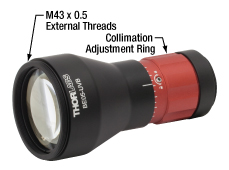
Click for Details
The 3X and 5X magnfication beam expanders share the same housing dimensions. Both versions have an M43 x 0.5-threaded output.
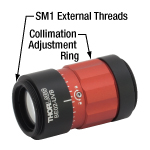
Click for Details
The 2X magnfication beam expanders have an externally SM1-threaded output.
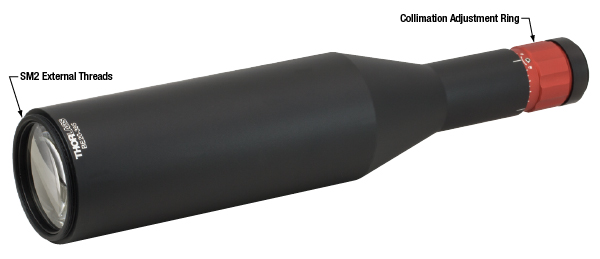
Click for Details
The 20X magnfication beam expanders have an SM2-threaded output.
Features
- 2X, 3X, 5X, 10X, or 20X Beam Expansion
- 5 AR Coating Options Covering Common Laser Lines:
- 240 - 360 nm Broadband (-UVB)
- 266 nm V-Coat (-266)
- 355 nm V-Coat (-355)
- 532 nm V-Coat (-532)
- 1064 nm V-Coat (-1064)
- Sliding Lens Collimation Adjustment that Minimizes Beam Walk Off
- Housing with Fixed Mechanical Length and Non-Rotating Ends
- Collimation Adjustment Ring can be Locked with Included Hex Key
- Threaded Apertures for Easy Integration into Optical Systems
Thorlabs' UV Fused Silica Beam Expanders can expand or reduce the diameter of a collimated beam by a factor of 2, 3, 5, 10, or 20. These Galilean beam expanders use a low-aberration, air-spaced design optimized to provide a wavefront error of less than λ/4 (i.e., diffraction-limited performance) and minimize the impact on the M2 value of the expanded beam. An expanded beam can be focused to a narrow diffraction-limited waist, which can be necessary for use with optics or instruments that have narrow input apertures such as our Fabry-Perot interferometers.
The optics used in the beam expanders have one of five AR coatings to minimize reflections at the air-to-glass interfaces. Beam expanders with an Item # ending in -UVB feature a broadband AR coating designed for 240 - 360 nm. The other beam expanders use optics with a V-coating, named for the shape of the reflectance curve, which reaches a minimum at the design wavelength and slopes steeply upwards on either side. This coating design provides a lower reflectance over a narrower operating range when compared to a broadband AR coating. The V-coatings for these beam expanders are centered on one of four wavelengths chosen to match Nd:YAG laser lines: 266 nm, 355 nm, 532 nm, or 1064 nm. The 20X beam expanders are available with a 355 nm, 532 nm, or 1064 nm V-coating only. See the Specs and AR Coatings tabs for more information on the coating performance.
The sliding lens design allows for the collimation to be adjusted while minimizing the beam walk-off effect that is inherent to lens adjustments. The red ring, shown in the photos to the right, is used to adjust the output beam collimation; once the desired collimation is obtained, the ring can be locked by tightening the locking screw using the included 0.05" hex key.
Mounting Options
The 2X, 3X, 5X, and 10X beam expanders have a smooth mounting surface with the same Ø1.2" diameter as our Ø1" lens tubes. The 20X beam expanders have a Ø2.20" smooth mounting surface, similar to that of our Ø2" lens tubes. Post mounting options include the SM1RC(/M) Lens Tube Slip Ring and SM1TC Lens Tube Clamp [SM2RC(/M) and SM2TC for 20X beam expanders]. Alternatively, the beam expanders can be integrated in one of our cage systems via the CP36 30 mm Cage Plate or by using the SM2A21 mounting adapter with the LCP35 60 mm Cage Plate (the 20X beam expanders may also be directly mounted in the LCP36 60 mm Cage Plate). Details are provided below. We also offer the SM1A52 adapter, which allows the input to be mated with components using the
These Galilean beam expanders also have threaded input and output apertures, which allow additional lenses and filters to be installed easily along the optical axis of the beam expander. The input of each beam expander has internal SM05 (0.535"-40) and external SM1 (1.035"-40) threads for ease of use with Thorlabs' lens tubes and other optical components. The output threading types are given in the tables below. All housings are designed so that the mounting surface and threaded ends do not rotate when turning the collimation adjustment ring, allowing the user to adjust the divergence without disturbing any attached optics and maintain pointing stability.
Thorlabs offers other fixed magnification beam expanders with achromatic designs for broadband applications, ZnSe optical elements for use in mid-IR applications, or reflective designs that use mirrors for cases where chromatic aberration is a concern. Variable magnification beam expanders, including our UV fused silica or achromatic zoom beam expanders, are also available. For more information on our extensive line of beam expanders, please see the Beam Expanders tab.
| Item # Prefix | BE02 | BE03 | BE05 | BE10 | BE20 |
|---|---|---|---|---|---|
| Expansion | 2X | 3X | 5X | 10X | 20X |
| Max Input Beam Diametera | 9.7 mm | 10.6 mm | 7.0 mm | 3.5 mm | 2.2 mm |
| Diffraction-Limited Input Beam Diametera,b | 8.5 mm | 9.0 mm | 4.3 mm | 2.8 mm | 2.0 mm |
| Closest Focusing Distancec | ±1.2 m | ±2.5 m | ±2.0 m | ±4.0 m | ±16 m |
| Input Thread | Internal: SM05 (0.535"-40) External: SM1 (1.035"-40) |
||||
| Output Thread | External SM1 (1.035"-40) | External M43 x 0.5d | External SM2 (2.035"-40) | ||
| Surface Quality | 10-5 Scratch-Dig | ||||
| Housing Dimensions | |||||
| Input Housing Diameter | 30.5 mm (1.20")e | ||||
| Output Housing Diameter | 30.5 mm (1.20")e | 45.0 mm (1.77") | 55.9 mm (2.20")f | ||
| Housing Length | 52.0 mm (2.05") | 85.5 mm (3.37") | 135.0 mm (5.31") | 267.0 mm (10.51") | |
| Mounting Optionsg | SM1RC(/M), SM1TC, CP36, SM2A21 | SM1RC(/M), SM1TC, CP36, SM2A21, SM2A30 | SM2RC(/M), SM2TC, LCP09 | ||
| AR Coating Specifications | |||||
|---|---|---|---|---|---|
| Item # Suffix | -UVB | -266 | -355 | -532 | -1064 |
| Typical Transmission | >93% @ 248 nm >95% @ 266 nm >94% @ 355 nm |
>98% @ 266 nm | >97% @ 355 nm | >98% @ 532 nm | >98% @ 1064 nm |
| AR Coating Type | 240 - 360 nm Broadband | 266 nm V-Coat | 355 nm V-Coat | 532 nm V-Coat | 1064 nm V-Coat |
| Max Reflectance | <1.5% (240 - 360 nm) | <0.7% (248 - 287 nm) <0.2% (256 - 275 nm) |
<0.7% (325 - 380 nm) <0.2% (335 - 362 nm) |
<0.7% (488 - 580 nm) <0.2% (503 - 553 nm) |
<0.7% (960 - 1160 nm) <0.2% (1000 - 1100 nm) |
| Average Reflectance | - | <0.2% (252 - 281 nm) | <0.2% (330 - 370 nm) | <0.2% (495 - 570 nm) | <0.2% (980 - 1130 nm) |
| Damage Thresholda | 5.0 J/cm² (355 nm, 10 ns Pulse, 20 Hz, Ø0.342 mm) |
5.0 J/cm² (266 nm, 10 ns Pulse, 10 Hz, Ø0.127 mm) |
10.0 J/cm² (355 nm, 10 ns Pulse, 10 Hz, Ø0.406 mm) |
15.0 J/cm² (532 nm, 10 ns Pulse, 20 Hz, Ø0.213 mm) |
20.0 J/cm² (1064 nm, 10 ns Pulse, 20 Hz, Ø0.395 mm) |
The lenses in the UV fused silica beam expanders have one of five AR coatings deposited on both sides of each optic in the beam expanders to minimize reflections at the air-to-glass interfaces. The graphs below show the reflectance per surface as a function of wavelength over an extended wavelength range. Each blue shaded region indicates the specified operating range of the coating; performance outside of this region is not guaranteed.
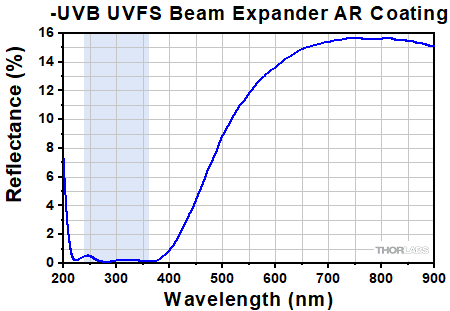
Click to Enlarge
Click Here for Raw Data
The reflectance per surface of the AR coating applied to the optics used in the -UVB UVFS beam expanders. The blue shaded region indicates the operating range where RMax < 1.5%. Performance outside of this region is provided for reference only and is not guaranteed.
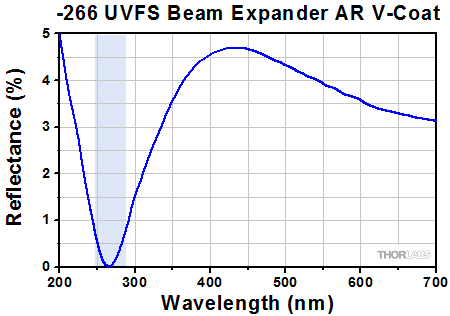
Click to Enlarge
Click Here for Raw Data
The reflectance per surface of the AR coating applied to the optics used in the -266 UVFS beam expanders. The blue shaded region indicates the operating range where RMax < 0.7%. Performance outside of this region is provided for reference only and is not guaranteed.
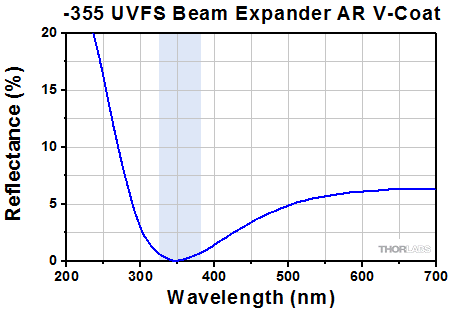
Click to Enlarge
Click Here for Raw Data
The reflectance per surface of the AR coating applied to the optics used in the -355 UVFS beam expanders. The blue shaded region indicates the operating range where RMax < 0.7%. Performance outside of this region is provided for reference only and is not guaranteed.
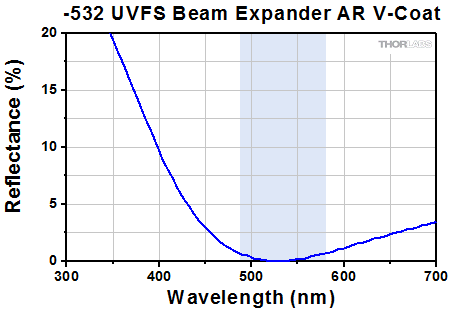
Click to Enlarge
Click Here for Raw Data
The reflectance per surface of the AR coating applied to the optics used in the -532 UVFS beam expanders. The blue shaded region indicates the operating range where RMax < 0.7%. Performance outside of this region is provided for reference only and is not guaranteed.
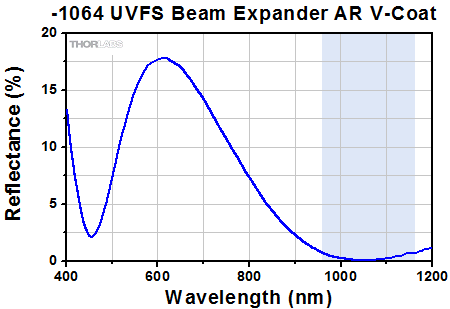
Click to Enlarge
Click Here for Raw Data
The reflectance per surface of the AR coating applied to the optics used in the -1064 UVFS beam expanders. The blue shaded region indicates the operating range where RMax < 0.7%. Performance outside of this region is provided for reference only and is not guaranteed.
| Damage Threshold Specifications | |
|---|---|
| Item # Suffix | Damage Threshold |
| -UVB | 5.0 J/cm² (355 nm, 10 ns Pulse, 20 Hz, Ø0.342 mm) |
| -266 | 5.0 J/cm² (266 nm, 10 ns Pulse, 10 Hz, Ø0.127 mm) |
| -355 | 10.0 J/cm² (355 nm, 10 ns Pulse, 10 Hz, Ø0.406 mm) |
| -532 | 15.0 J/cm² (532 nm, 10 ns Pulse, 20 Hz, Ø0.213 mm) |
| -1064 | 20.0 J/cm² (1064 nm, 10 ns Pulse, 20 Hz, Ø0.395 mm) |
Damage Threshold Data for Thorlabs' UV Fused Silica Beam Expanders
The specifications to the right are measured data for Thorlabs' UV Fused Silica Beam Expanders.
Laser Induced Damage Threshold Tutorial
The following is a general overview of how laser induced damage thresholds are measured and how the values may be utilized in determining the appropriateness of an optic for a given application. When choosing optics, it is important to understand the Laser Induced Damage Threshold (LIDT) of the optics being used. The LIDT for an optic greatly depends on the type of laser you are using. Continuous wave (CW) lasers typically cause damage from thermal effects (absorption either in the coating or in the substrate). Pulsed lasers, on the other hand, often strip electrons from the lattice structure of an optic before causing thermal damage. Note that the guideline presented here assumes room temperature operation and optics in new condition (i.e., within scratch-dig spec, surface free of contamination, etc.). Because dust or other particles on the surface of an optic can cause damage at lower thresholds, we recommend keeping surfaces clean and free of debris. For more information on cleaning optics, please see our Optics Cleaning tutorial.
Testing Method
Thorlabs' LIDT testing is done in compliance with ISO/DIS 11254 and ISO 21254 specifications.
First, a low-power/energy beam is directed to the optic under test. The optic is exposed in 10 locations to this laser beam for 30 seconds (CW) or for a number of pulses (pulse repetition frequency specified). After exposure, the optic is examined by a microscope (~100X magnification) for any visible damage. The number of locations that are damaged at a particular power/energy level is recorded. Next, the power/energy is either increased or decreased and the optic is exposed at 10 new locations. This process is repeated until damage is observed. The damage threshold is then assigned to be the highest power/energy that the optic can withstand without causing damage. A histogram such as that below represents the testing of one BB1-E02 mirror.

The photograph above is a protected aluminum-coated mirror after LIDT testing. In this particular test, it handled 0.43 J/cm2 (1064 nm, 10 ns pulse, 10 Hz, Ø1.000 mm) before damage.

| Example Test Data | |||
|---|---|---|---|
| Fluence | # of Tested Locations | Locations with Damage | Locations Without Damage |
| 1.50 J/cm2 | 10 | 0 | 10 |
| 1.75 J/cm2 | 10 | 0 | 10 |
| 2.00 J/cm2 | 10 | 0 | 10 |
| 2.25 J/cm2 | 10 | 1 | 9 |
| 3.00 J/cm2 | 10 | 1 | 9 |
| 5.00 J/cm2 | 10 | 9 | 1 |
According to the test, the damage threshold of the mirror was 2.00 J/cm2 (532 nm, 10 ns pulse, 10 Hz, Ø0.803 mm). Please keep in mind that these tests are performed on clean optics, as dirt and contamination can significantly lower the damage threshold of a component. While the test results are only representative of one coating run, Thorlabs specifies damage threshold values that account for coating variances.
Continuous Wave and Long-Pulse Lasers
When an optic is damaged by a continuous wave (CW) laser, it is usually due to the melting of the surface as a result of absorbing the laser's energy or damage to the optical coating (antireflection) [1]. Pulsed lasers with pulse lengths longer than 1 µs can be treated as CW lasers for LIDT discussions.
When pulse lengths are between 1 ns and 1 µs, laser-induced damage can occur either because of absorption or a dielectric breakdown (therefore, a user must check both CW and pulsed LIDT). Absorption is either due to an intrinsic property of the optic or due to surface irregularities; thus LIDT values are only valid for optics meeting or exceeding the surface quality specifications given by a manufacturer. While many optics can handle high power CW lasers, cemented (e.g., achromatic doublets) or highly absorptive (e.g., ND filters) optics tend to have lower CW damage thresholds. These lower thresholds are due to absorption or scattering in the cement or metal coating.

LIDT in linear power density vs. pulse length and spot size. For long pulses to CW, linear power density becomes a constant with spot size. This graph was obtained from [1].

Pulsed lasers with high pulse repetition frequencies (PRF) may behave similarly to CW beams. Unfortunately, this is highly dependent on factors such as absorption and thermal diffusivity, so there is no reliable method for determining when a high PRF laser will damage an optic due to thermal effects. For beams with a high PRF both the average and peak powers must be compared to the equivalent CW power. Additionally, for highly transparent materials, there is little to no drop in the LIDT with increasing PRF.
In order to use the specified CW damage threshold of an optic, it is necessary to know the following:
- Wavelength of your laser
- Beam diameter of your beam (1/e2)
- Approximate intensity profile of your beam (e.g., Gaussian)
- Linear power density of your beam (total power divided by 1/e2 beam diameter)
Thorlabs expresses LIDT for CW lasers as a linear power density measured in W/cm. In this regime, the LIDT given as a linear power density can be applied to any beam diameter; one does not need to compute an adjusted LIDT to adjust for changes in spot size, as demonstrated by the graph to the right. Average linear power density can be calculated using the equation below.

The calculation above assumes a uniform beam intensity profile. You must now consider hotspots in the beam or other non-uniform intensity profiles and roughly calculate a maximum power density. For reference, a Gaussian beam typically has a maximum power density that is twice that of the uniform beam (see lower right).
Now compare the maximum power density to that which is specified as the LIDT for the optic. If the optic was tested at a wavelength other than your operating wavelength, the damage threshold must be scaled appropriately. A good rule of thumb is that the damage threshold has a linear relationship with wavelength such that as you move to shorter wavelengths, the damage threshold decreases (i.e., a LIDT of 10 W/cm at 1310 nm scales to 5 W/cm at 655 nm):

While this rule of thumb provides a general trend, it is not a quantitative analysis of LIDT vs wavelength. In CW applications, for instance, damage scales more strongly with absorption in the coating and substrate, which does not necessarily scale well with wavelength. While the above procedure provides a good rule of thumb for LIDT values, please contact Tech Support if your wavelength is different from the specified LIDT wavelength. If your power density is less than the adjusted LIDT of the optic, then the optic should work for your application.
Please note that we have a buffer built in between the specified damage thresholds online and the tests which we have done, which accommodates variation between batches. Upon request, we can provide individual test information and a testing certificate. The damage analysis will be carried out on a similar optic (customer's optic will not be damaged). Testing may result in additional costs or lead times. Contact Tech Support for more information.
Pulsed Lasers
As previously stated, pulsed lasers typically induce a different type of damage to the optic than CW lasers. Pulsed lasers often do not heat the optic enough to damage it; instead, pulsed lasers produce strong electric fields capable of inducing dielectric breakdown in the material. Unfortunately, it can be very difficult to compare the LIDT specification of an optic to your laser. There are multiple regimes in which a pulsed laser can damage an optic and this is based on the laser's pulse length. The highlighted columns in the table below outline the relevant pulse lengths for our specified LIDT values.
Pulses shorter than 10-9 s cannot be compared to our specified LIDT values with much reliability. In this ultra-short-pulse regime various mechanics, such as multiphoton-avalanche ionization, take over as the predominate damage mechanism [2]. In contrast, pulses between 10-7 s and 10-4 s may cause damage to an optic either because of dielectric breakdown or thermal effects. This means that both CW and pulsed damage thresholds must be compared to the laser beam to determine whether the optic is suitable for your application.
| Pulse Duration | t < 10-9 s | 10-9 < t < 10-7 s | 10-7 < t < 10-4 s | t > 10-4 s |
|---|---|---|---|---|
| Damage Mechanism | Avalanche Ionization | Dielectric Breakdown | Dielectric Breakdown or Thermal | Thermal |
| Relevant Damage Specification | No Comparison (See Above) | Pulsed | Pulsed and CW | CW |
When comparing an LIDT specified for a pulsed laser to your laser, it is essential to know the following:

LIDT in energy density vs. pulse length and spot size. For short pulses, energy density becomes a constant with spot size. This graph was obtained from [1].
- Wavelength of your laser
- Energy density of your beam (total energy divided by 1/e2 area)
- Pulse length of your laser
- Pulse repetition frequency (prf) of your laser
- Beam diameter of your laser (1/e2 )
- Approximate intensity profile of your beam (e.g., Gaussian)
The energy density of your beam should be calculated in terms of J/cm2. The graph to the right shows why expressing the LIDT as an energy density provides the best metric for short pulse sources. In this regime, the LIDT given as an energy density can be applied to any beam diameter; one does not need to compute an adjusted LIDT to adjust for changes in spot size. This calculation assumes a uniform beam intensity profile. You must now adjust this energy density to account for hotspots or other nonuniform intensity profiles and roughly calculate a maximum energy density. For reference a Gaussian beam typically has a maximum energy density that is twice that of the 1/e2 beam.
Now compare the maximum energy density to that which is specified as the LIDT for the optic. If the optic was tested at a wavelength other than your operating wavelength, the damage threshold must be scaled appropriately [3]. A good rule of thumb is that the damage threshold has an inverse square root relationship with wavelength such that as you move to shorter wavelengths, the damage threshold decreases (i.e., a LIDT of 1 J/cm2 at 1064 nm scales to 0.7 J/cm2 at 532 nm):

You now have a wavelength-adjusted energy density, which you will use in the following step.
Beam diameter is also important to know when comparing damage thresholds. While the LIDT, when expressed in units of J/cm², scales independently of spot size; large beam sizes are more likely to illuminate a larger number of defects which can lead to greater variances in the LIDT [4]. For data presented here, a <1 mm beam size was used to measure the LIDT. For beams sizes greater than 5 mm, the LIDT (J/cm2) will not scale independently of beam diameter due to the larger size beam exposing more defects.
The pulse length must now be compensated for. The longer the pulse duration, the more energy the optic can handle. For pulse widths between 1 - 100 ns, an approximation is as follows:

Use this formula to calculate the Adjusted LIDT for an optic based on your pulse length. If your maximum energy density is less than this adjusted LIDT maximum energy density, then the optic should be suitable for your application. Keep in mind that this calculation is only used for pulses between 10-9 s and 10-7 s. For pulses between 10-7 s and 10-4 s, the CW LIDT must also be checked before deeming the optic appropriate for your application.
Please note that we have a buffer built in between the specified damage thresholds online and the tests which we have done, which accommodates variation between batches. Upon request, we can provide individual test information and a testing certificate. Contact Tech Support for more information.
[1] R. M. Wood, Optics and Laser Tech. 29, 517 (1998).
[2] Roger M. Wood, Laser-Induced Damage of Optical Materials (Institute of Physics Publishing, Philadelphia, PA, 2003).
[3] C. W. Carr et al., Phys. Rev. Lett. 91, 127402 (2003).
[4] N. Bloembergen, Appl. Opt. 12, 661 (1973).
In order to illustrate the process of determining whether a given laser system will damage an optic, a number of example calculations of laser induced damage threshold are given below. For assistance with performing similar calculations, we provide a spreadsheet calculator that can be downloaded by clicking the button to the right. To use the calculator, enter the specified LIDT value of the optic under consideration and the relevant parameters of your laser system in the green boxes. The spreadsheet will then calculate a linear power density for CW and pulsed systems, as well as an energy density value for pulsed systems. These values are used to calculate adjusted, scaled LIDT values for the optics based on accepted scaling laws. This calculator assumes a Gaussian beam profile, so a correction factor must be introduced for other beam shapes (uniform, etc.). The LIDT scaling laws are determined from empirical relationships; their accuracy is not guaranteed. Remember that absorption by optics or coatings can significantly reduce LIDT in some spectral regions. These LIDT values are not valid for ultrashort pulses less than one nanosecond in duration.

A Gaussian beam profile has about twice the maximum intensity of a uniform beam profile.
CW Laser Example
Suppose that a CW laser system at 1319 nm produces a 0.5 W Gaussian beam that has a 1/e2 diameter of 10 mm. A naive calculation of the average linear power density of this beam would yield a value of 0.5 W/cm, given by the total power divided by the beam diameter:

However, the maximum power density of a Gaussian beam is about twice the maximum power density of a uniform beam, as shown in the graph to the right. Therefore, a more accurate determination of the maximum linear power density of the system is 1 W/cm.
An AC127-030-C achromatic doublet lens has a specified CW LIDT of 350 W/cm, as tested at 1550 nm. CW damage threshold values typically scale directly with the wavelength of the laser source, so this yields an adjusted LIDT value:

The adjusted LIDT value of 350 W/cm x (1319 nm / 1550 nm) = 298 W/cm is significantly higher than the calculated maximum linear power density of the laser system, so it would be safe to use this doublet lens for this application.
Pulsed Nanosecond Laser Example: Scaling for Different Pulse Durations
Suppose that a pulsed Nd:YAG laser system is frequency tripled to produce a 10 Hz output, consisting of 2 ns output pulses at 355 nm, each with 1 J of energy, in a Gaussian beam with a 1.9 cm beam diameter (1/e2). The average energy density of each pulse is found by dividing the pulse energy by the beam area:

As described above, the maximum energy density of a Gaussian beam is about twice the average energy density. So, the maximum energy density of this beam is ~0.7 J/cm2.
The energy density of the beam can be compared to the LIDT values of 1 J/cm2 and 3.5 J/cm2 for a BB1-E01 broadband dielectric mirror and an NB1-K08 Nd:YAG laser line mirror, respectively. Both of these LIDT values, while measured at 355 nm, were determined with a 10 ns pulsed laser at 10 Hz. Therefore, an adjustment must be applied for the shorter pulse duration of the system under consideration. As described on the previous tab, LIDT values in the nanosecond pulse regime scale with the square root of the laser pulse duration:

This adjustment factor results in LIDT values of 0.45 J/cm2 for the BB1-E01 broadband mirror and 1.6 J/cm2 for the Nd:YAG laser line mirror, which are to be compared with the 0.7 J/cm2 maximum energy density of the beam. While the broadband mirror would likely be damaged by the laser, the more specialized laser line mirror is appropriate for use with this system.
Pulsed Nanosecond Laser Example: Scaling for Different Wavelengths
Suppose that a pulsed laser system emits 10 ns pulses at 2.5 Hz, each with 100 mJ of energy at 1064 nm in a 16 mm diameter beam (1/e2) that must be attenuated with a neutral density filter. For a Gaussian output, these specifications result in a maximum energy density of 0.1 J/cm2. The damage threshold of an NDUV10A Ø25 mm, OD 1.0, reflective neutral density filter is 0.05 J/cm2 for 10 ns pulses at 355 nm, while the damage threshold of the similar NE10A absorptive filter is 10 J/cm2 for 10 ns pulses at 532 nm. As described on the previous tab, the LIDT value of an optic scales with the square root of the wavelength in the nanosecond pulse regime:

This scaling gives adjusted LIDT values of 0.08 J/cm2 for the reflective filter and 14 J/cm2 for the absorptive filter. In this case, the absorptive filter is the best choice in order to avoid optical damage.
Pulsed Microsecond Laser Example
Consider a laser system that produces 1 µs pulses, each containing 150 µJ of energy at a repetition rate of 50 kHz, resulting in a relatively high duty cycle of 5%. This system falls somewhere between the regimes of CW and pulsed laser induced damage, and could potentially damage an optic by mechanisms associated with either regime. As a result, both CW and pulsed LIDT values must be compared to the properties of the laser system to ensure safe operation.
If this relatively long-pulse laser emits a Gaussian 12.7 mm diameter beam (1/e2) at 980 nm, then the resulting output has a linear power density of 5.9 W/cm and an energy density of 1.2 x 10-4 J/cm2 per pulse. This can be compared to the LIDT values for a WPQ10E-980 polymer zero-order quarter-wave plate, which are 5 W/cm for CW radiation at 810 nm and 5 J/cm2 for a 10 ns pulse at 810 nm. As before, the CW LIDT of the optic scales linearly with the laser wavelength, resulting in an adjusted CW value of 6 W/cm at 980 nm. On the other hand, the pulsed LIDT scales with the square root of the laser wavelength and the square root of the pulse duration, resulting in an adjusted value of 55 J/cm2 for a 1 µs pulse at 980 nm. The pulsed LIDT of the optic is significantly greater than the energy density of the laser pulse, so individual pulses will not damage the wave plate. However, the large average linear power density of the laser system may cause thermal damage to the optic, much like a high-power CW beam.
| Posted Comments: | |
Ralf Kops
(posted 2024-04-09 10:37:17.763) BE05-1064 - 5X UVFS High-Power Beam Expander, V-Coated for 1064 nm
File looks corrupt can´t read it as stp 214 file.
Can you send me please a good volume model in stp format.
Thanks.
BE03-1064 makes no problem ! srydberg
(posted 2024-04-10 08:04:05.0) Hi, thank you for the feedback! The file has been updated now. Yelei Sun
(posted 2021-01-13 05:42:38.123) I am not able to open the Step file of BE05-266. Can you please check and fix the problem? YLohia
(posted 2021-01-22 02:07:07.0) Hello, thank you for bringing this to our attention. We have fixed the issue on the website and reached out to you with a working file. benny kirshner
(posted 2020-08-20 17:39:18.587) Hi
Can you please share BE05-266 acceptance angles and the impact of a tillted beam on the wave front error ?
I'm planning to have a ~3mm beam at the input.
Benny nbayconich
(posted 2020-08-24 12:44:54.0) Thank you for contacting Thorlabs. The wavefront error as a function of incident angle can be simulated in zemax using our provided black box files. The wavefront error will increase with increasing AOI. I will reach out to you directly to share more information regarding these beam expanders. Taras Shvets
(posted 2020-08-05 12:59:53.54) .step file corrupter, can't imported it. can you send me good one, please YLohia
(posted 2020-08-05 03:19:16.0) Thank you for contacting Thorlabs. I have reached out to you with a working STEP file. user
(posted 2019-04-07 09:52:47.74) Dear sir,
Please tell me how to use ELU-25-2.5X-351.I can't find it's manual.But i hope you can teach me easily by Email.
Think you! YLohia
(posted 2019-04-22 04:00:38.0) Hello, thank you for contacting Thorlabs. One of our Applications Engineers will reach out to you directly. adonazzan
(posted 2018-09-21 16:20:08.623) What's the collimating range (in mrad) for the BE02-1064? No specification is reported for divergence compensation capabilities on the output beam. nbayconich
(posted 2018-09-28 03:12:09.0) Thank you for contacting Thorlabs. The resulting divergence is dependent on the input beam diameter. We recommend using the Zemax blackbox file available on the website to simulate the divergence using the Paraxial Gaussian Beam tool in Zemax. When turning the collimation adjustment ring, the inner lens cell moves +/-5mm around the nominal lens position. mikael.malmstrom
(posted 2017-09-28 14:28:16.333) I want to simulate the beam propagation for 532 nm in the 2X system. What is the focal length of the lenses inside, and how much can I adjust the distance between them? tfrisch
(posted 2017-11-14 11:39:47.0) Hello, thank you for contacting Thorlabs. While the exact lens design is proprietary, you can make some assumptions just knowing that this is a Galilean Beam Expander about 50mm long. The sum of the focal lengths of the two lenses will be roughly equal to the lens spacing and the shorter focal length will be negative. We will reach out to you directly about appropriate estimates. shinh
(posted 2014-11-19 23:35:32.05) I would like to ask what is the focal length of each lens of EL-25-5X-A ? cdaly
(posted 2014-11-25 01:51:26.0) Response from Chris at Thorlabs: I'm afraid the details of the optics used to create the beam expanders is considered proprietary. We would not be able to provide these values. allen.zwan
(posted 2014-07-23 09:54:10.183) i would like to expand a 3kw 1.06 beam from 2mm to approx 800mm (~X400)collimnated , would you have a solution for this? jlow
(posted 2014-08-07 02:42:00.0) Response from Jeremy at Thorlabs: To expand a beam to 800mm, you would need an optic that is at least 800mm in size. This is not something that we have at the moment. andreas.kaidatzis
(posted 2013-11-29 15:02:44.397) I have an EL-25-5X-A for reducing a collimated laser beam, but the output beam is diverging. I guess that the silver part should slide in order to adjust collimation, but in my case it won't move... Even when the lock screws are loose... Do I make something wrong..?
Thanks in advance! tcohen
(posted 2013-12-05 02:57:17.0) Response from Tim at Thorlabs: Thanks for contacting us with this. We’ve emailed you to assist directly. andreas.kaidatzis
(posted 2013-10-10 04:47:05.343) I would like to ask what is the maximum input beam diameter for perfroming X5 reduction (using EL-25-5X-A). I see on specs that for performing expansion, the maximum input beam diameter is 2.2 mm (10.9 mm input aperture). Is is the same for reduction? pbui
(posted 2013-10-10 16:17:00.0) Response from Phong at Thorlabs: The maximum input beam diameter for beam reduction should be equal to the maximum input beam diameter for beam expansion times the magnification. For the EL-25-5X-A, this would give a max input beam of 2.2 mm * 5 = 11 mm. user
(posted 2009-05-05 03:31:30.0) By using an adapter, SM2B2 (http://www.thorlabs.com/thorProduct.cfm?partNumber=SM2B2), that slides over the body of the beam expander, you can then thread it into a cage plate with SM2 threads. This way you can attach the beam expander very close to its center of gravity or even right on it if you remove the mounting saddle. techsupport
(posted 2009-05-04 17:33:00.0) A response from Erin at Thorlabs to Wei:
In order to mount the beam expander into a cage system you can use a system similar to the SM1A9 thread adapter, which will go from C-Mount (which is accessible once the end cap is removed from the input side of the expander) to our SM1 thread. From this adapter you could use the SM1T2 to connect to the LCP02. This will allow you to directly connect to the 60mm cage system over the expander and to the 30mm cage system before the input to the expander, if this is the system you are currently using. Unfortunately, due to the weight of the beam expander, this would not be able to completely support the weight, so we recommend using a post on the bottom of the expander to support it. Please note that it does have ¼-20 and M6 threaded holes on the bottom, so you could mount it to a pillar post. For more details on this, please let me know the total height of your cage system and any other details you have about it and I can help you find the correct solution. Please also let me know if you have any further questions on our products and I will be happy to help you. Have a nice day.
SM1A9 C-Mount to SM1 Adapter: http://www.thorlabs.com/thorProduct.cfm?partNumber=SM1A9
LCP02 Cage Plate Adapter: http://www.thorlabs.com/thorProduct.cfm?partNumber=LCP02
SM1T2 Thread Nut: http://www.thorlabs.com/thorProduct.cfm?partNumber=SM1T2
Drawing of EL-25-5X-A: http://www.thorlabs.com/Thorcat/17400/17485-E0W.pdf zhaow2
(posted 2009-05-04 12:36:53.0) Is there a way I put EL-25-5X-A into the cage system?
thanks,
Wei |
Thorlabs offers fixed magnification beam expanders, as well as zoom beam expanders that do not need to be refocused when the magnification is adjusted since the collimation remains constant. The table below provides a direct comparison of the options we offer. Please contact Tech Support if you would like help choosing the best beam expander for your specific application.
| Beam Expander Description |
Fixed Magnification UVFS Laser Line, Sliding Lens |
Fixed Magnification Achromatic, Sliding Lens |
Fixed Magnification Mid-Infrared, Sliding Lens |
|---|---|---|---|
| Expansions Available | 2X, 3X, 5X, 10X, 20Xa | 2X, 3X, 5X, 10X, 15X, 20X |
2X, 5X, 10X |
| AR Coating Range(s) (Item # Suffix) |
240 - 360 nm (-UVB) 248 - 287 nm (-266) 325 - 380 nm (-355) 488 - 580 nm (-532) 960 - 1064 nm (-1064) |
400 - 650 nm (-A) 650 - 1050 nm (-B) 1050 - 1650 nm (-C) |
7 - 12 μm (-E3) |
| Mirror Coating (Range) | N/A | ||
| Reflectance (per Surface) | Rmax < 1.5% (-UVB) Ravg < 0.2% (All Others) |
Rmax < 0.5% | Ravg < 1.0% |
| Max Input Beam Diameter | 2X: 8.5 mm 3X: 9.0 mm 5X: 4.3 mm 10X: 2.8 mm 20X: 2.0 mm |
2X: 8.5 mm 3X: 9.0 mm 5X: 5.0 mm 10X: 3.0 mm 15X: 2.5 mm 20X: 2.0 mm |
2X: 9.5 mm 5X: 6.7 mm 10X: 3.5 mm |
| Wavefront Error | <λ/4 (Peak to Valley) | ||
| Surface Quality | 10-5 Scratch-Dig | 20-10 Scratch-Dig | 80-50 Scratch-Dig |
| Beam Expander Description |
Zoom UVFS, Sliding Lens |
Zoom Achromatic, Sliding Lens |
Reflective Beam Expander Fixed Magnification |
|---|---|---|---|
| Expansions Available | 0.5X - 2.5X, 1X - 4X, 2X - 8X, 4X - 16X |
0.5X - 2.5X, 1X - 4X, 2X - 8X, 4X - 16X |
2X, 4X, 6X |
| AR Coating Range(s) (Item # Suffix) |
240 - 360 nm (UVB) 330 - 370 nm (3) 495 - 570 nm (2) 980 - 1130 nm (1) |
400 - 650 nm (A) 650 - 1050 nm (B) 1050 - 1650 nm (C) |
N/A |
| Mirror Coating (Range) | N/A | Protected Silver (450 nm - 20 μm) |
|
| Rmax < 1.5% for (UVB) Ravg < 0.2% (All Others) |
Rmax < 0.5% | Ravg > 95% | |
| Max Input Beam Diameter | 0.5X - 2.5X: 10.9 to 8.0 mm 1X - 4X: 10.9 to 8.8 mm 2X - 8X: 6.0 to 4.4 mm 4X - 16X: 6.0 to 2.7 mm |
0.5X - 2.5X: 10.9 to 8.0 mm 1X - 4X: 10.9 to 8.8 mm 2X - 8X: 6.0 to 4.4 mm 4X - 16X: 6.0 to 2.7 mm |
3 mm |
| Wavefront Error | <λ/4 (Peak to Valley) | <λ/10a (RMS) | |
| Surface Quality | 10-5 Scratch-Dig | 20-10 Scratch-Dig | 40-20 Scratch-Dig |

| Item # | Expansion | Max Input Beam Diameter | Diffraction-Limited Input Beam Diametera | Input Thread | Output Thread (External) | AR Coating Max Reflectance | Typical Transmission | Damage Thresholdb |
|---|---|---|---|---|---|---|---|---|
| BE02-UVB | 2X | 9.7 mm | 8.5 mm | Internal: SM05 External: SM1 |
SM1 | <1.5% (240 - 360 nm) | >93% @ 248 nm >95% @ 266 nm >94% @ 355 nm |
5.0 J/cm² (355 nm, 10 ns Pulse, 20 Hz, Ø0.342 mm) |
| BE03-UVB | 3X | 10.6 mm | 9.0 mm | M43 x 0.5c | ||||
| BE05-UVB | 5X | 7.0 mm | 4.3 mm | |||||
| BE10-UVB | 10X | 3.5 mm | 2.8 mm |

| Item # | Expansion | Max Input Beam Diameter | Diffraction-Limited Input Beam Diametera | Input Thread | Output Thread (External) | AR Coating Max Reflectance | Typical Transmission | Damage Thresholdb |
|---|---|---|---|---|---|---|---|---|
| BE02-266 | 2X | 9.7 mm | 8.5 mm | Internal: SM05 External: SM1 |
SM1 | <0.7% (248 - 287 nm) <0.2% (256 - 275 nm) |
>98% @ 266 nm | 5.0 J/cm² (266 nm, 10 ns Pulse, 10 Hz, Ø0.127 mm) |
| BE03-266 | 3X | 10.6 mm | 9.0 mm | M43 x 0.5c | ||||
| BE05-266 | 5X | 7.0 mm | 4.3 mm | |||||
| BE10-266 | 10X | 3.5 mm | 2.8 mm |

| Item # | Expansion | Max Input Beam Diameter |
Diffraction-Limited Input Beam Diametera |
Input Thread | Output Thread (External) |
AR Coating Max Reflectance |
Typical Transmission |
Damage Thresholdb |
|---|---|---|---|---|---|---|---|---|
| BE02-355 | 2X | 9.7 mm | 8.5 mm | Internal: SM05 External: SM1 |
SM1 | <0.7% (325 - 380 nm) <0.2% (335 - 362 nm) |
>97% @ 355 nm | 10.0 J/cm² (355 nm, 10 ns Pulse, 10 Hz, Ø0.406 mm) |
| BE03-355 | 3X | 10.6 mm | 9.0 mm | M43 x 0.5c | ||||
| BE05-355 | 5X | 7.0 mm | 4.3 mm | |||||
| BE10-355 | 10X | 3.5 mm | 2.8 mm | |||||
| BE20-355 | 20X | 2.2 mm | 2.0 mm | SM2 |

| Item # | Expansion | Max Input Beam Diameter |
Diffraction-Limited Input Beam Diametera |
Input Thread | Output Thread (External) |
AR Coating Max Reflectance |
Typical Transmission |
Damage Thresholdb |
|---|---|---|---|---|---|---|---|---|
| BE02-532 | 2X | 9.7 mm | 8.5 mm | Internal: SM05 External: SM1 |
SM1 | <0.7% (488 - 580 nm) <0.2% (503 - 553 nm) |
>98% @ 532 nm | 15.0 J/cm² (532 nm, 10 ns Pulse, 20 Hz, Ø0.213 mm) |
| BE03-532 | 3X | 10.6 mm | 9.0 mm | M43 x 0.5c | ||||
| BE05-532 | 5X | 7.0 mm | 4.3 mm | |||||
| BE10-532 | 10X | 3.5 mm | 2.8 mm | |||||
| BE20-532 | 20X | 2.2 mm | 2.0 mm | SM2 |

| Item # | Expansion | Max Input Beam Diameter |
Diffraction-Limited Input Beam Diametera |
Input Thread | Output Thread (External) |
AR Coating Max Reflectance |
Typical Transmission |
Damage Thresholdb |
|---|---|---|---|---|---|---|---|---|
| BE02-1064 | 2X | 9.7 mm | 8.5 mm | Internal: SM05 External: SM1 |
SM1 | <0.7% (960 - 1160 nm) <0.2% (1000 - 1100 nm) |
>98% @ 1064 nm | 20.0 J/cm² (1064 nm, 10 ns Pulse, 20 Hz, Ø0.395 mm) |
| BE03-1064 | 3X | 10.6 mm | 9.0 mm | M43 x 0.5c | ||||
| BE05-1064 | 5X | 7.0 mm | 4.3 mm | |||||
| BE10-1064 | 10X | 3.5 mm | 2.8 mm | |||||
| BE20-1064 | 20X | 2.2 mm | 2.0 mm | SM2 |

Several mounting options for the UVFS Beam Expanders are provided in the table below. For our complete selection of thread adapters, see our Optical Component Thread Adapters selection guide.
| Item # | SM1RC(/M) | SM2RC(/M) | SM1TC | SM2TC | CP36 | LCP36 | SM2A21 | SM2A30 |
|---|---|---|---|---|---|---|---|---|
| Photo (Click to Enlarge) |
 |
 |
 |
 |
 |
 |
 |
 |
| Application | Slip Ring for Post Mounting | Clamp for Post Mounting | 30 mm Cage Mount for Ø1.2" Housing | 60 mm Cage Mount for Ø2.2" Housing | Mount Beam Expander in Ø2" or SM2-Threaded Optic Mounts |
Integrate Beam Expander with SM2-Threaded Components | ||
| Compatible UVFS Beam Expanders (Item # Prefix) | BE02 BE03 BE05 BE10 |
BE20 | BE02 BE03 BE05 BE10 |
BE20 | BE02 BE03a BE05a BE10a |
BE20 | BE02 BE03 BE05 BE10 |
BE03 BE05 BE10 |
| Internal Bore / Threads |
Ø1.2" Bore | Ø2.2" Bore | Ø1.2" Bore | Ø2.2" Bore | Ø1.2" Bore | Ø2.2" Bore | Ø1.2" Bore | M43 x 0.5 Threads |
| - | - | - | - | - | - | SM2 Threads and Ø2" Smooth Surface |
SM2 Threads | |
| Mounting Holes | 8-32 (M4) Tap | #8 (M4) Counterbore | Compatible with 30 mm Cage Systems |
Compatible with 60 mm Cage Systems |
- | - | ||
 Products Home
Products Home













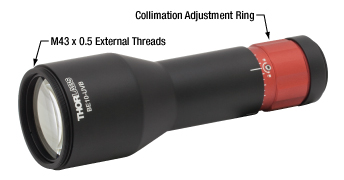

 Fixed Magnification UVFS
Fixed Magnification UVFS